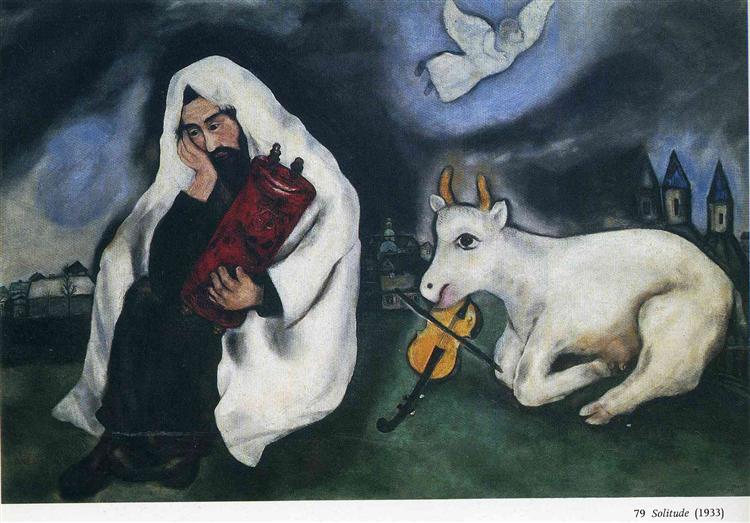Artists
Chagall, Marc - by David Jeffrey
Marc Chagall: Solitude

Hagah
by David Lyle Jeffrey
Chagall was born in Vitebsk, in what was then Polish Lithuania and is now Belorussia. He descended from and lived among Hasidic Jews, followers of the Baal Shem Tov (Master of the Good Name), and the spirituality of his community was accordingly marked deeply by prayer, mystical experience and joyous celebration as much as by the study of Torah itself. Chagall, who studied the Bible each Sabbath afternoon in Hebrew as a boy, was also influenced by Kabbalah mysticism and, later in life, increasingly appreciated and integrated Christian symbolism, even of the Crucifixion, into his art. Though he was not regular in his Jewish observance, he is visually the most Jewish (and most biblical) of modernist painters.
This tranquil painting of Marc Chagall may seem to a reader unfamiliar with the Hebrew Bible a serene reflection on the centrality of Torah in orthodox Jewish life, but also somewhat surreal. Angel aside, how are we to understand the contented cow and the fiddle? It turns out that both are intrinsic to the meaning of this painting, the experience of religious meditation itself – quiet personal reflection on the words of Scripture – but also on the role of the arts as a medium for such meditation.
It helps us to know that a cow chewing its cud has a Hebraic biblical meaning: as a verb hagah means ‘to chew the cud’ and can also be used in the metaphorical sense found in English, where someone can be said to ‘ruminate’ on something that requires reflective thought. Thus it appears as a key verb where Moses in his final words to the people says, “This Sepher Torah shall not depart from your mouth, but you shall meditate in it day and night, that you may observe to do all that is written in it” (Joshua 1:8). Psalm 1:2 echoes Moses’ injunction to ‘chew over’ the lessons of Torah; by analogy with the peaceful cow, a spiritually flourishing person is one who ‘meditates’ on the Word of God day and night, when he lies down and when he rises up. One of the ways in which such meditation deepens and becomes articulate in other registers of the imagination (for Christians as well as Jews) is through the responsive commentary afforded by the arts.
Chagall often uses the violin in his paintings to symbolize a wide range of empathetic reflection in Jewish religious life and Hasidic spirituality especially. In this painting we may recognize a juxtaposition of Scripture and meditation. Such meditation may issue in prayer (tepillah) or in sung prayers (tehellim) such as the zemiros; it might as readily emerge in a haunting melody on the violin, or in this beautiful painting itself. For Chagall, art may help attune us to a higher inspiration, symbolized by the angel hovering over the city. The image is a richly meditative reflection on the blessedness spoken of in Psalm 1:2, “delight in the Law of the Lord” as it is meditated upon day and night. Chagall’s painting thus draws us to participate in that multifaceted reflection on Scripture which is characteristic of the faithful Jewish or Christian life.
*******
David Lyle Jeffrey is Distinguished Professor of Literature and the Humanities at Baylor University. His current project is a book on art and theology, specifically in regard to the development of doctrine.


